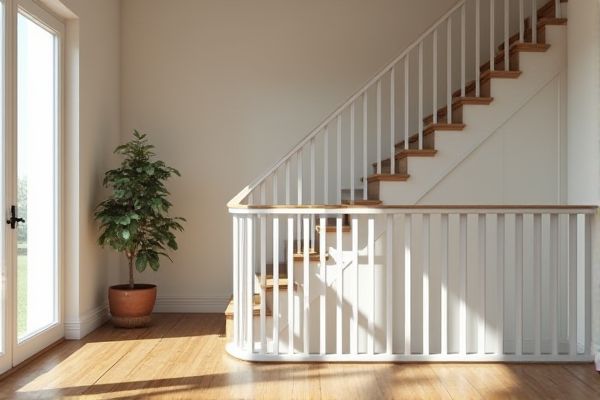
Horizontal railing offers a modern, open aesthetic and can visually expand the space, while vertical railing provides a classic look with enhanced safety by preventing climbing and offering better support. Discover how to choose the right style for your home's design and safety needs by reading the full article.
Table of Comparison
| Feature | Horizontal Railing | Vertical Railing |
|---|---|---|
| Design Style | Modern, sleek, contemporary | Classic, traditional, timeless |
| Safety | May pose climbing risk for children | Provides better safety with less climbing hazard |
| Installation | Requires precise alignment for aesthetics | Generally easier and faster to install |
| Maintenance | Easier to clean horizontal bars | Vertical bars may accumulate less dirt |
| Visual Impact | Creates open, expansive views | Defines boundaries clearly, less open view |
| Material Compatibility | Works well with metal, wood, cable | Compatible with wood, metal, wrought iron |
| Cost | Often more expensive due to design complexity | Usually more affordable and widely available |
Introduction to Horizontal and Vertical Railings
Horizontal railings feature parallel bars that run sideways, offering a modern aesthetic and unobstructed views, commonly used in contemporary architecture. Vertical railings consist of upright balusters, providing enhanced safety by preventing climbing and meeting many building codes for residential and commercial use. Both designs vary in installation, maintenance, and visual impact, influencing the overall style and function of staircases, balconies, and decks.
Design Aesthetics: Modern vs Traditional
Horizontal railing designs emphasize sleek, modern aesthetics with clean, continuous lines that visually expand spaces and create a contemporary appeal. Vertical railings offer a traditional look characterized by evenly spaced balusters, providing a classic, timeless charm and enhanced structural stability. Selecting between horizontal and vertical railings significantly impacts the overall architectural style, balancing modern minimalism against conventional design values.
Safety Considerations: Horizontal vs Vertical Railings
Vertical railings are generally considered safer for preventing climbs, especially in environments with children, as their design reduces the risk of footholds. Horizontal railings may pose a higher risk of accidental climbing, potentially leading to falls, making them less suitable for areas prioritizing child safety. Building codes often favor vertical railings for residential and commercial applications due to these safety considerations.
Installation Process and Complexity
Horizontal railing installation typically requires precise alignment and secure anchoring to ensure safety, often involving more careful measurement and additional hardware for stability. Vertical railing installation is generally more straightforward, with evenly spaced balusters simply attached to top and bottom rails, making it easier and faster for DIY projects or standard construction. Understanding your space and skill level will help determine if the slightly more complex horizontal railing installation suits your needs better than the simpler vertical option.
Material Options and Durability
Horizontal railings often use materials like steel, aluminum, and wood, offering sleek modern aesthetics and strong resistance to weather conditions when properly treated. Vertical railings commonly feature wrought iron, vinyl, or stainless steel, known for their classic appeal and enhanced durability against corrosion and impact. Your choice should consider the material's maintenance requirements and longevity to ensure lasting structural integrity and safety.
Maintenance Requirements and Longevity
Horizontal railings typically require more frequent maintenance due to their greater exposure to elements and potential for debris accumulation, which can accelerate wear and tear. Vertical railings benefit from better water runoff and reduced debris buildup, often resulting in longer lifespan and lower upkeep costs. Choosing vertical railing can optimize your investment by minimizing maintenance efforts and extending durability over time.
Cost Comparison: Horizontal vs Vertical Railings
Horizontal railings generally cost less than vertical railings due to simpler fabrication and installation processes, using fewer materials and less labor time. Vertical railings often require more precision and additional supports, increasing overall expenses and maintenance costs. When choosing your railing, consider that horizontal designs offer budget-friendly solutions without sacrificing style or safety.
Best Applications and Suitable Spaces
Horizontal railings are best suited for modern architectural designs and open spaces such as terraces, balconies, and decks where an unobstructed view is desired, enhancing the sense of openness. Vertical railings work well in residential staircases, safety enclosures, and traditional homes, providing a classic look while ensuring higher safety by preventing climbing hazards. Both types vary in suitability based on aesthetic preferences, safety standards, and the intended spatial function.
Building Codes and Legal Compliance
Building codes typically mandate specific requirements for railing designs to prevent climbing hazards, often restricting the use of horizontal railings in residential settings due to their potential safety risks. Vertical railings are generally favored in legal compliance because their design minimizes the risk of children climbing and falling, aligning with many international safety standards such as the International Residential Code (IRC). Adhering to these codes is essential to avoid legal liabilities and ensure safety compliance in both residential and commercial construction projects.
Choosing the Right Railing for Your Project
Horizontal railing offers a modern aesthetic and unobstructed views, making it ideal for contemporary deck or balcony designs, while vertical railing provides enhanced safety and complies with stricter building codes, especially in homes with children or pets. Consider the surrounding environment, style preferences, and local regulations to ensure your railing choice balances visual appeal with functionality and security. Prioritize your project's specific needs, as selecting the right railing enhances both safety and overall design coherence.
 homyna.com
homyna.com